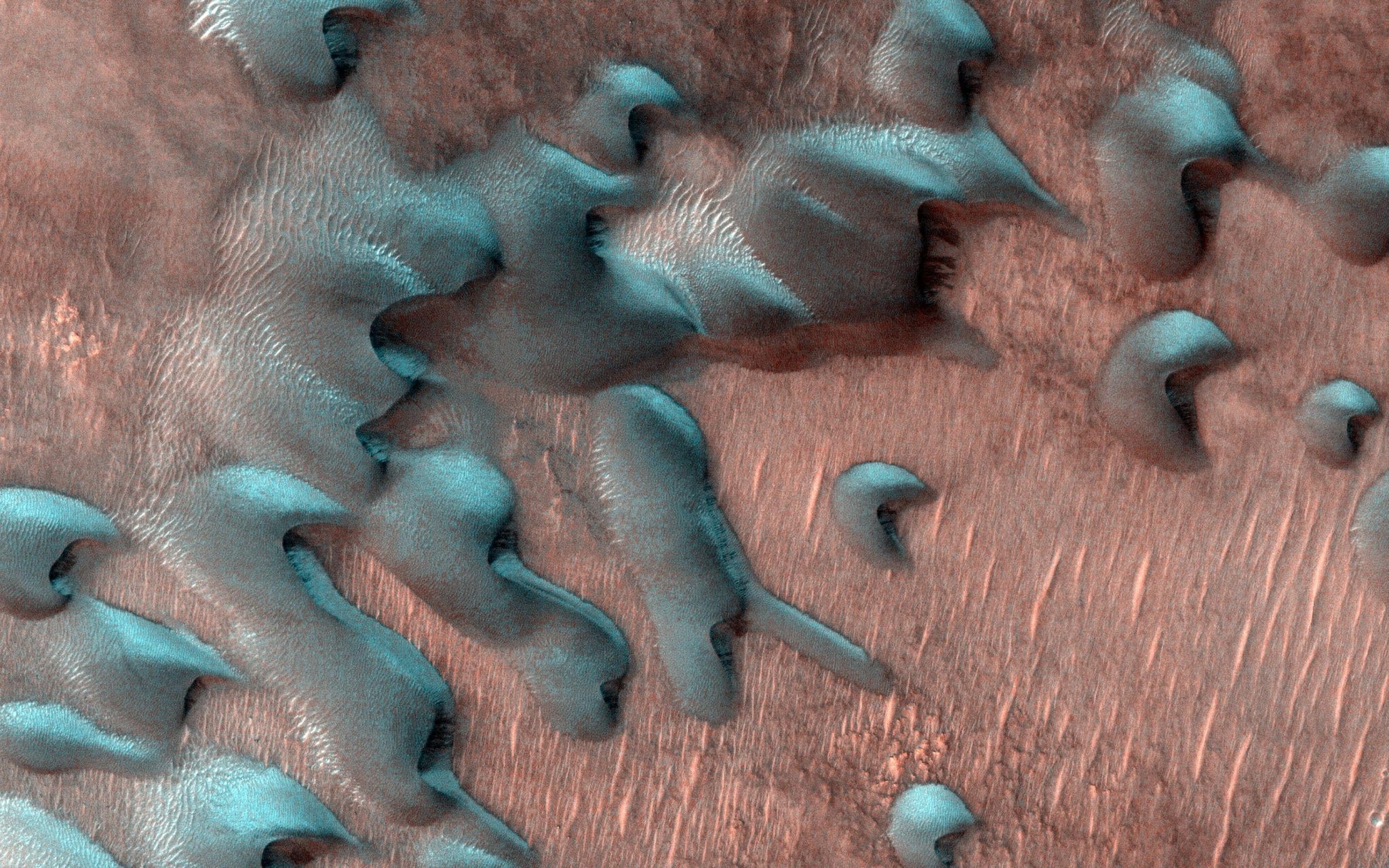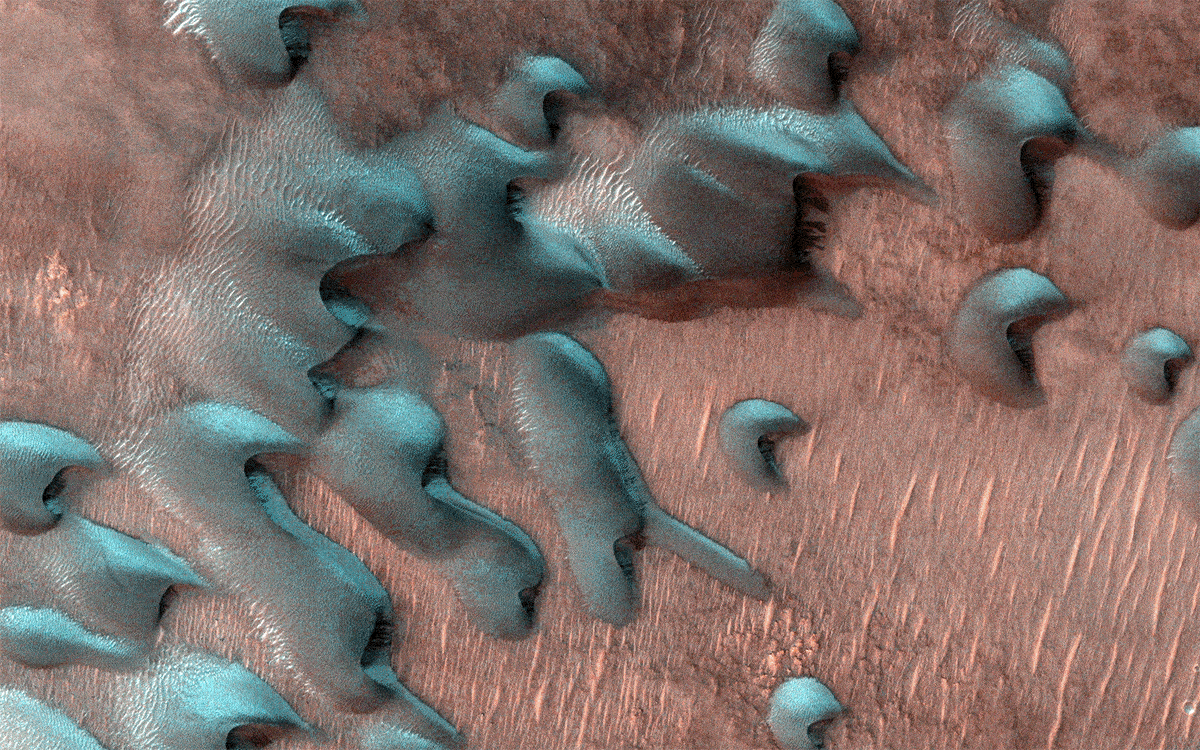
NASA의 Mars Reconnaissance Orbiter에 탑재된 HiRISE 카메라는 동지 직후 서리 덮인 모래 언덕의 이미지를 포착했습니다. 이곳의 서리는 이산화탄소(마른) 얼음과 물눈의 혼합물이며 봄이 오면 몇 달 안에 사라집니다. 이미지 제공: NASA/JPL-Caltech/University of Arizona
입방체 모양의 눈, 얼어붙은 풍경, 서리는 모두 붉은 행성에서 가장 추운 계절의 일부입니다.
겨울이 오면[{” attribute=””>Mars, the surface is transformed into a truly otherworldly holiday scene. Snow, ice, and frost accompany the season’s sub-zero temperatures. Some of the coldest of these occur at the planet’s poles, where it gets as low as minus 190 degrees Fahrenheit (minus 123 degrees Celsius).
Cold as it is, don’t expect snow drifts worthy of the Rocky Mountains. No region of Mars gets more than a few feet of snow, most of which falls over extremely flat areas. And the Red Planet’s elliptical orbit means it takes many more months for winter to come around: a single Mars year is around two Earth years.
화성에서도 눈이 내리고 얼음과 서리가 형성됩니다.[{” attribute=””>NASA’s spacecraft on and orbiting the Red Planet reveal the similarities to and differences from how we experience winter on Earth. Mars scientist Sylvain Piqueux of JPL explains in this video. Credit: NASA/JPL-Caltech
Still, the planet offers unique winter phenomena that scientists have been able to study, thanks to NASA’s robotic Mars explorers. Here are a few of the things they’ve discovered:
Two Kinds of Snow
Martian snow comes in two varieties: water ice and carbon dioxide, or dry ice. Because Martian air is so thin and the temperatures so cold, water-ice snow sublimates, or becomes a gas, before it even touches the ground. Dry-ice snow actually does reach the ground.
“Enough falls that you could snowshoe across it,” said Sylvain Piqueux, a Mars scientist at NASA’s Jet Propulsion Laboratory in Southern California whose research includes a variety of winter phenomena. “If you were looking for skiing, though, you’d have to go into a crater or cliffside, where snow could build up on a sloped surface.”

HiRISE captured these “megadunes,” also called barchans. Carbon dioxide frost and ice have formed over the dunes during the winter; as this starts to sublimate during spring, the darker-colored dune sand is revealed. Credit: NASA/JPL-Caltech/University of Arizona
How We Know It Snows
Snow occurs only at the coldest extremes of Mars: at the poles, under cloud cover, and at night. Cameras on orbiting spacecraft can’t see through those clouds, and surface missions can’t survive in the extreme cold. As a result, no images of falling snow have ever been captured. But scientists know it happens, thanks to a few special science instruments.
NASA’s Mars Reconnaissance Orbiter can peer through cloud cover using its Mars Climate Sounder instrument, which detects light in wavelengths imperceptible to the human eye. That ability has allowed scientists to detect carbon dioxide snow falling to the ground. And in 2008, NASA sent the Phoenix lander within 1,000 miles (about 1,600 kilometers) of Mars’ north pole, where it used a laser instrument to detect water-ice snow falling to the surface.
NASA 과학자들은 폭풍 속에서 눈 입자 분포의 크기와 모양을 층별로 측정할 수 있습니다. Global Precipitation Measurement Mission은 3시간마다 전 세계의 비와 눈에 대한 차세대 관측을 제공하는 국제 위성 프로젝트입니다. 출처: NASA의 고다드 우주 비행 센터/Ryan Fitzgibbons
얼음 조각
물 분자가 얼 때 함께 결합되는 방식 때문에 지구상의 눈송이는 6면을 가집니다. 동일한 원리가 모든 결정에 적용됩니다. 원자가 스스로를 구성하는 방식이 결정의 모양을 결정합니다. 이산화탄소의 경우, 드라이아이스의 분자는 얼었을 때 항상 4자로 모입니다.
Bicchio는 “이산화탄소 얼음은 4개의 대칭을 가지고 있기 때문에 마른 눈송이가 정육면체 모양이 될 것이라는 것을 알고 있습니다.”라고 말했습니다. “화성의 기후가 더 안전해져서 우리는 이 눈송이가 사람의 머리카락 굵기보다 작을 것이라고 말할 수 있습니다.”

HiRISE 카메라는 한겨울에 분화구 가장자리의 이 이미지를 포착했습니다. 햇빛을 적게 받는 분화구의 남향 경사면 모양은 고르지 못하고 밝은 서리로 이 강화된 색상 이미지에서 파란색으로 표시됩니다. 이미지 제공: NASA/JPL-Caltech/University of Arizona
당신의 로버에서 잭 프로스트가 갉아먹습니다.
물과 이산화탄소 모두 화성에서 서리를 형성할 수 있으며 두 가지 유형의 서리는 눈보다 행성 전체에 더 광범위하게 나타납니다. 바이킹 착륙선은 1970년대에 화성을 연구할 때 물 서리를 보았고 NASA의 오디세이 궤도선은 서리 형성이 관찰되고 승화됩니다. 아침 해.

HiRISE는 토양에서 얼어붙은 얼음이 지구를 다각형으로 분할하는 이 봄 장면을 포착했습니다. 투명한 이산화탄소 얼음은 햇빛이 빛나고 통풍구를 통해 스며드는 가스를 가열하여 표면에서 더 어두운 물질의 팬을 발사합니다(이 향상된 색상 이미지에서 파란색으로 표시됨). 이미지 제공: NASA/JPL-Caltech/University of Arizona
이상한 겨울의 끝
아마도 가장 놀라운 발견은 생성된 모든 얼음이 “녹아” 대기로 승화되기 시작하는 겨울이 끝날 때일 것입니다. 그렇게 함으로써 이 얼음은 과학자들에게 거미그리고 달마시안 반점그리고 젖통그리고 스위스 치즈.
이 “녹는 것”은 또한 간헐천을 폭발시킵니다. 투명한 얼음은 햇빛이 아래의 가스를 가열할 수 있게 하고 그 가스는 결국 폭발합니다. 먼지 팬 지붕에. 과학자들은 이미 팬에 대해 더 많이 알기 위한 방법으로 이러한 팬을 연구하기 시작했습니다. 화성의 바람은 어느 방향으로 불고 있습니까?.

“음악 팬. 매우 겸손한 탐험가. 분석가. 여행 괴짜. 익스트림 TV 전문가. 게이머.”



/cdn.vox-cdn.com/uploads/chorus_asset/file/25619621/247271_Spectacles_2024_NHernandez_Melo_0015.jpg)






